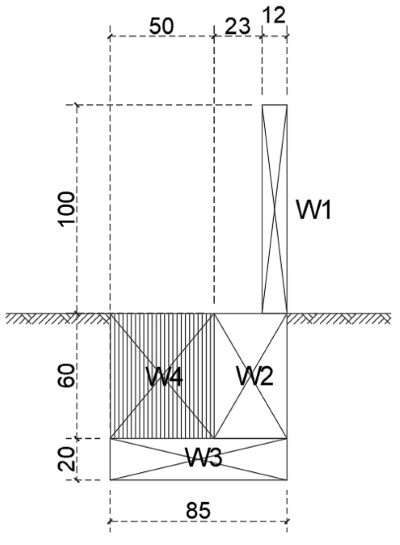Retaining Wall Design in Addressing the Waterlogging Problem in Tambaklorok
DOI:
https://doi.org/10.24036/cived.v12i1.734Keywords:
Retaining Wall, Drilled Pile Foundation, Foundation Bearing CapacityAbstract
North Semarang is a densely populated area. Several villages are located not only on the North Coast of Java but also at the mouth of the Semarang River, and these villages are often hit by inundation floods. One of the causes of flooding in Tambak Lorok, Semarang is land subsidence and high tide or ROB. To handle the inundation that occurs, a study of the calculation of the retaining wall structure to hold back the inundation so that it does not enter the Old GIS Switchyard of Tambak Lorok Substation Semarang. The retaining wall planned with a total height of 1.8 m and a bottom width of 0.85 m is stable to the bearing capacity of the soil and safe against overturning and sliding. The bearing capacity of 18 drill pile foundation points with a diameter of 40 cm at a depth of 14 meters is sufficient to withstand the retaining wall and the load above it (350,424 tons > 264,384 tons).
Downloads
References
Y. Zhang, C. L. Chow, and D. Lau, “Artificial intelligence-enhanced non-destructive defect detection for civil infrastructure,” Automation in Construction, vol. 171, pp. 105996–105996, Jan. 2025, doi: https://doi.org/10.1016/j.autcon.2025.105996.
H. Zhuang, Y. Cheng, M. Zhou, and Z. Yang, “Deep learning for surface crack detection in civil engineering: A comprehensive review,” Measurement, pp. 116908–116908, Feb. 2025, doi: https://doi.org/10.1016/j.measurement.2025.116908.
H.-B. Chen, X.-Y. Shao, L. Han, M.-G. Li, F.-Q. Chen, and X.-L. Xie, “A comprehensive prediction of stability against cantilever retaining walls using finite element limit analysis and neural networks model,” KSCE Journal of Civil Engineering, pp. 100200–100200, Feb. 2025, doi: https://doi.org/10.1016/j.kscej.2025.100200.
K. Liu, J.-J. Chen, J.-W. Kang, and X.-H. Liu, “A Novel Simplified Analytical Approach for Calculating the Load-Displacement of Axially Loaded Piles,” KSCE Journal of Civil Engineering, pp. 100147–100147, Dec. 2024, doi: https://doi.org/10.1016/j.kscej.2024.100147.
L. Jin, P. Liu, W. Yao, J. Wei, and Z. Li, “Safety assessment of existing subgrade retaining wall based on a combined Weighting-TOPSIS evaluation method,” Developments in the Built Environment, vol. 18, pp. 100420–100420, Mar. 2024, doi: https://doi.org/10.1016/j.dibe.2024.100420.
J. R. Vivanco, P. Breul, A. TALON, M. A. Benz-Navarrete, S. Barbier, and Y. Haddani, “Importance of geotechnical diagnosis in railway management: A review,” Transportation Engineering, vol. 18, p. 100293, Dec. 2024, doi: https://doi.org/10.1016/j.treng.2024.100293.
A. Van Lerberghe et al., “Data-driven parametric modelling of split-Hopkinson pressure bar tests on cohesive soils,” International Journal of Impact Engineering, vol. 198, p. 105218, Jan. 2025, doi: https://doi.org/10.1016/j.ijimpeng.2024.105218.

Downloads
Published
How to Cite
Issue
Section
License
Copyright (c) 2025 Melinda Dwi Rahmawati, Ahmad Rifa'i, Fajar Dwi Satriaji

This work is licensed under a Creative Commons Attribution 4.0 International License.







2.jpg)
